An Updated Theoretical Framework for Human Sexual Selection: from Ecology, Genetics, and Life History to Extended Phenotypes
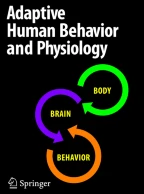
Sexual selection typically centers on bodily and psychological traits. Non-bodily traits ranging from housing and vehicles through art to social media can, however, influence sexual selection even in absence of the phenotype proper. The theoretical framework of human sexual selection is updated in this article by unifying four theoretical approaches and conceptualizing non-bodily traits as extended phenotypic traits.
Methods
Existing research is synthesized with extended phenotype theory, life history theory, and behavioral ecology. To test population-level hypotheses arising from the review, ecological and demographic data on 122 countries are analyzed with multiple linear regression modelling.
Results
A four-factor model of intelligence, adolescent fertility, population density, and atmospheric cold demands predicts 64% of global variation in economic complexity in 1995 and 72% of the variation in 2016.
Conclusions
The evolutionary pathways of extended phenotypes frequently undergo a categorical broadening from providing functional benefits to carrying signalling value. Extended phenotypes require investments in skills and bioenergetic resources, but they can improve survival in high latitudes, facilitate the extraction of resources from the environment, and substantially influence sexual selection outcomes. Bioenergetic investments in extended phenotypes create individual- and population-level tradeoffs with competing life history processes, exemplified here as a global tradeoff between adolescent fertility and economic complexity. The merits of the present model include a more systematic classification of sexual traits, a clearer articulation of their evolutionary-developmental hierarchy, and an analysis of ecological, genetic, and psychological mechanisms that modulate the flow of energy into extended phenotypes and cultural innovations.
This is a preview of subscription content, log in via an institution to check access.
Access this article
Subscribe and save
Springer+ Basic
€32.70 /Month
- Get 10 units per month
- Download Article/Chapter or eBook
- 1 Unit = 1 Article or 1 Chapter
- Cancel anytime
Buy Now
Price includes VAT (France)
Instant access to the full article PDF.
Rent this article via DeepDyve
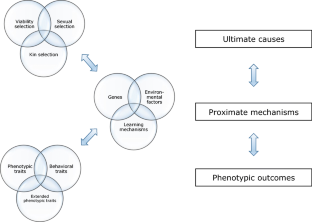
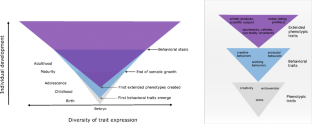
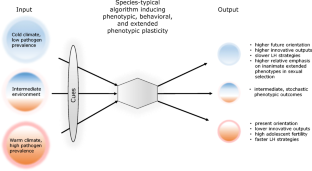
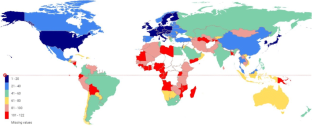

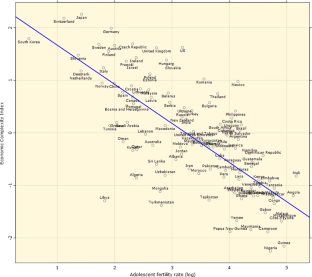
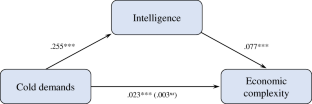
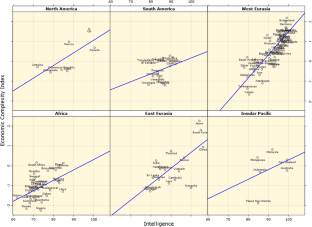
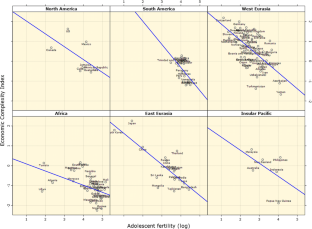

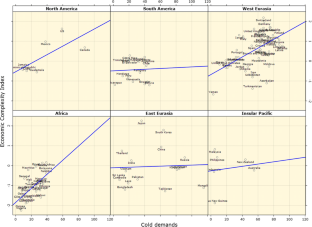
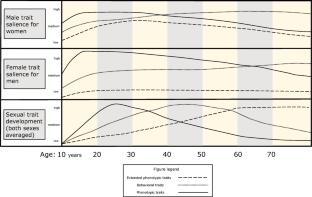
Similar content being viewed by others
Demographic studies enhance the understanding of evolutionarily (mal)adaptive behaviors and phenomena in humans: a review on fertility decline and an integrated model
Article 03 November 2017

Studying Sex Differences in Psychosocial Life History Indicators
Article 17 August 2019
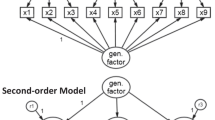
Advancing the Psychometric Study of Human Life History Indicators
Article 28 May 2021
Notes
Inherited wealth may be an exception. In a limited number of cases, the causal succession from a phenotype to behavior to extended phenotypes can potentially skip the intermediate step behavior.
A possible exception may be fat tissue metabolized via excessive energy intake or muscle tissue growth stimulated by adaptations to physical work or exercise (Camera et al. 2016; Wells 2006).
Equatorial distance is a proxy of climate: it correlates significantly (r = .90) with daily minimum temperature (IJzerman et al. 2017) and cold demands (r = .88, as described below).
See Roth and Pravosudov (2009), Vincze (2016), and especially Fristoe et al. (2017), for similar results in bird species, as well as a discussion on direction of causality, which suggests that, in birds, it was brain expansion that led to the colonization of variable habitats rather than colonization of variable habitats leading to brain expansion.
Brussels was chosen as a proxy for Europe’s central point for the present purposes since it is located between Europe’s geographical centre (Suchowola, Poland) and financial centre (London, UK) and constitutes the administrative centre of the European Union.
Spearman’s rank correlation coefficient was used because of non-normal distribution of data for the variable coldest month.
References
- Andrews, T. M., Lukaszewski, A. W., Simmons, Z. L., & Bleske-Rechek, A. (2017). Cue-based estimates of reproductive value explain women's body attractiveness. Evolution and Human Behavior, 38(4), 461–467. https://doi.org/10.1016/j.evolhumbehav.2017.04.002. Google Scholar
- Antfolk, J., Salo, B., Alanko, K., Bergen, E., Corander, J., Sandnabba, N. K., & Santtila, P. (2015). Women's and men's sexual preferences and activities with respect to the partner's age: Evidence for female choice. Evolution and Human Behavior, 36(1), 73–79. https://doi.org/10.1016/j.evolhumbehav.2014.09.003. Google Scholar
- Archer, I. W. (2011a). Economy. In A. F. Kinney (Ed.), The Oxford Handbook of Shakespeare (pp. 165–181). Oxford: Oxford University Press. https://doi.org/10.1093/oxfordhb/9780199566105.013.0010.
- Archer, J. (2011b). Pet keeping: A case study in maladaptive behavior. In C. Salmon & T. K. Shackelford (Eds.), The Oxford handbook of evolutionary family psychology (pp. 281–296). Oxford: Oxford University Press. Google Scholar
- Ardiel, E. L., & Rankin, C. H. (2010). An elegant mind: Learning and memory in Caenorhabditis elegans. Learning & Memory, 17(4), 191–201. https://doi.org/10.1101/lm.960510. Google Scholar
- Arslan, R. C., Schilling, K. M., Gerlach, T. M., & Penke, L. (2018). Using 26,000 diary entries to show ovulatory changes in sexual desire and behavior. Journal of Personality and Social Psychology. https://doi.org/10.1037/pspp0000208.
- Ash, J., & Gallup, G. G. (2007). Paleoclimatic variation and brain expansion during human evolution. Human Nature, 18(2), 109–124. Google Scholar
- Austen, J. (2007/1813). Pride and Prejudice. In Ebrary, Chandni Chowk, Delhi: Global Media.
- Azam, S. (2017). A cross-country empirical test of cognitive abilities and innovation nexus. International Journal of Educational Development, 53, 128–136. Google Scholar
- Bailey, N. W. (2012). Evolutionary models of extended phenotypes. Trends in Ecology & Evolution, 27(10), 561–569. Google Scholar
- Bailey, D. H., & Geary, D. C. (2009). Hominid brain evolution. Human Nature, 20(1), 67–79. https://doi.org/10.1007/s12110-008-9054-0. Google Scholar
- Ball, H. C., Londraville, R. L., Prokop, J. W., George, J. C., Suydam, R. S., Vinyard, C., Thewissen, J. G. M., & Duff, R. J. (2017). Beyond thermoregulation: Metabolic function of cetacean blubber in migrating bowhead and beluga whales. Journal of Comparative Physiology B, 187(1), 235–252. https://doi.org/10.1007/s0036. Google Scholar
- Barbot, B., Tan, M., & Grigorenko, E. L. (2013). The genetics of creativity: The generative and receptive sides of the creativity equation. In O. Vartanian, A. S. Bristol, & J. C. Kaufman (Eds.), The neuroscience of creativity (pp. 71–93). Cambridge: MIT Press. Google Scholar
- Barelds, D. P., & Barelds-Dijkstra, P. (2007). Love at first sight or friends first? Ties among partner personality trait similarity, relationship onset, relationship quality, and love. Journal of Social and Personal Relationships, 24(4), 479–496. Google Scholar
- Barton, R. A., & Venditti, C. (2014). Rapid evolution of the cerebellum in humans and other great apes. Current Biology, 24(20), 2440–2444. Google Scholar
- Bateson, P., & Gluckman, P. (2011). Plasticity, robustness, development and evolution. Cambridge: Cambridge University Press. Google Scholar
- Baumard, N. (2018). Psychological origins of the industrial revolution. Behavioral and Brain Sciences, 1–47. https://doi.org/10.1017/S0140525X1800211X.
- Beck, S. R., Chappell, J., Apperly, I. A., & Cutting, N. (2012). Tool innovation may be a critical limiting step for the establishment of a rich tool-using culture: A perspective from child development. Behavioral and Brain Sciences, 35(4), 220–221. Google Scholar
- Bereczkei, T., Voros, S., Gal, A., & Bernath, L. (1997). Resources, attractiveness, family commitment; reproductive decisions in human mate choice. Ethology, 103(8), 681–699. Google Scholar
- Black, C. J., Figueredo, A. J., & Jacobs, W. J. (2017). Substance, history, and politics: An examination of the conceptual underpinnings of alternative approaches to the life history narrative. Evolutionary Psychology, 15(1), 1474704916670402. Google Scholar
- Blake, K. R., Dixson, B. J., O'Dean, S. M., & Denson, T. F. (2017). No compelling positive association between ovarian hormones and wearing red clothing when using multinomial analyses. Hormones and Behavior, 90, 129–135. Google Scholar
- Blake, K. R., Bastian, B., Denson, T. F., Grosjean, P., & Brooks, R. C. (2018). Income inequality not gender inequality positively covaries with female sexualization on social media. Proceedings of the National Academy of Sciences, 115(35), 8722–8727. https://doi.org/10.1073/pnas.1717959115. Google Scholar
- Blamires, S. J. (2010). Plasticity in extended phenotypes: Orb web architectural responses to variations in prey parameters. The Journal of Experimental Biology, 213(18), 3207–3212. https://doi.org/10.1242/jeb.045583. Google Scholar
- Blamires, S. J., Hasemore, M., Martens, P. J., & Kasumovic, M. M. (2017). Diet-induced co-variation between architectural and physicochemical plasticity in an extended phenotype. The Journal of Experimental Biology, 220(Pt 5), 876–884. https://doi.org/10.1242/jeb.150029. Google Scholar
- Blamires, S. J., Martens, P. J., & Kasumovic, M. M. (2018). Fitness consequences of plasticity in an extended phenotype. Journal of Experimental Biology, 221(4), jeb167288. https://doi.org/10.1242/jeb.167288. Google Scholar
- Bolondi, A., Caldarelli, F., Di Felice, F., Durano, D., Germani, G., Michetti, L., et al. (2017). What is a gene? A two sided view. Evolutionary Biology, 44(1), 1–4. https://doi.org/10.1007/s11692-016-9392-5. Google Scholar
- Botchkavar, E., Marshell, I. H., Rocque, M., & Posick, C. (2015). The importance of parenting in the development of self-control in boys and girls: Results from a multinational study of youth. Journal of Criminal Justice, 34, 133–141. https://doi.org/10.1016/j.jcrimjus.2015.02.001. Google Scholar
- Boutwell, B. B., Barnes, J. C., Beaver, K. M., Haynes, R. D., Nedelec, J. L., & Gibson, C. L. (2015). A unified crime theory: The evolutionary taxonomy. Aggression and Violent Behavior, 25, 343–353. Google Scholar
- Boyd, B. (2009). On the origin of stories: Evolution, cognition, and fiction. Cambridge: Harvard University Press. Google Scholar
- Bribiescas, R. G., Ellison, P. T., & Gray, P. B. (2012). Male life history, reproductive effort, and the evolution of the genus homo. Current Anthropology, 53(S6), S424–S435. https://doi.org/10.1086/667538. Google Scholar
- Briedis, M., Hahn, S., & Adamík, P. (2017). Cold spell en route delays spring arrival and decreases apparent survival in a long-distance migratory songbird. BMC Ecology, 17(1), 11. https://doi.org/10.1186/s12898-017-0121-4. Google Scholar
- Bukowski, A., & Rudnicki, S. (2018). Not Only Individualism: The Effects of Long-Term Orientation and Other Cultural Variables on National Innovation Success. Cross-Cultural Research, 1-44, 1069397118785546. https://doi.org/10.1177/1069397118785546.
- Burger, J. R., Weinberger, V. P., & Marquet, P. A. (2017). Extra-metabolic energy use and the rise in human hyper-density. Scientific Reports, 7. https://doi.org/10.1038/srep43869.
- Burke, D., Sulikowski, D., Stephen, I., & Brooks, R. (2017). Inconsistent with the data: Support for the CLASH model depends on the wrong kind of latitude. Behavioral and Brain Sciences, 40, e80. https://doi.org/10.1017/S0140525X16001242,e80. Google Scholar
- Buss, D. M. (1989). Sex differences in human mate preferences: Evolutionary hypotheses tested in 37 cultures. Behavioral and Brain Sciences, 12(01), 1–14. Google Scholar
- Buss, D. M., Abbott, M., Angleitner, A., Asherian, A., Biaggio, A., Blanco-Villasenor, A., . Deraad, B. (1990). International preferences in selecting mates: A study of 37 cultures. Journal of Cross-Cultural Psychology, 21(1), 5–47.
- Buss, D. M., Haselton, M. G., Shackelford, T. K., Bleske, A. L., & Wakefield, J. C. (1998). Adaptations, exaptations, and spandrels. American Psychologist, 53(5), 533–548. https://doi.org/10.1037/0003-066X.53.5.533. Google Scholar
- Buston, P. M., & Emlen, S. T. (2003). Cognitive processes underlying human mate choice: The relationship between self-perception and mate preference in western society. Proceedings of the National Academy of Sciences of the United States of America, 100(15), 8805–8810. https://doi.org/10.1073/pnas.1533220100. Google Scholar
- Cain, K. E., & Ketterson, E. D. (2012). Competitive females are successful females; phenotype, mechanism, and selection in a common songbird. Behavioral Ecology and Sociobiology, 66, 241–252. Google Scholar
- Camera, D. M., Smiles, W. J., & Hawley, J. A. (2016). Exercise-induced skeletal muscle signaling pathways and human athletic performance. Free Radical Biology and Medicine, 98, 131–143. https://doi.org/10.1016/j.freeradbiomed.2016.02.007. Google Scholar
- Candolin, U. (2003). The use of multiple cues in mate choice. Biological Reviews, 78(4), 575–595. Google Scholar
- Carleton, W. C., Campbell, D., & Collard, M. (2017). Increasing temperature exacerbated classic Maya conflict over the long term. Quaternary Science Reviews, 163, 209–218. https://doi.org/10.1016/j.quascirev.2017.02.022. Google Scholar
- Carneiro, R. L. (1970). A theory of the origin of the state: Traditional theories of state origins are considered and rejected in favor of a new ecological hypothesis. Science, 169(3947), 733–738. Google Scholar
- Casey, B., Jones, R. M., & Hare, T. A. (2008). The adolescent brain. Annals of the New York Academy of Sciences, 1124(1), 111–126. Google Scholar
- Cedeño Laurent, J. G., Williams, A., Oulhote, Y., Zanobetti, A., Allen, J. G., & Spengler, D. A. (2018). Reduced cognitive function during a heat wave among residents of non-air-conditioned buildings: An observational study of young adults in the summer of 2016. PLoS Medicine, 15(7), e1002605. https://doi.org/10.1371/journal.pmed.1002605. Google Scholar
- Chappell, J., Cutting, N., Apperly, I. A., & Beck, S. R. (2013). The development of tool manufacture in humans: What helps young children make innovative tools? Philosophical Transactions of the Royal Society, B: Biological Sciences, 368(1630), 20120409. https://doi.org/10.1098/rstb.2012.0409. Google Scholar
- Charney, E. (2012). Behavior genetics and postgenomics. Behavioral and Brain Sciences, 35(5), 331–358. https://doi.org/10.1017/S0140525X11002226. Google Scholar
- Christin, A. (2012). Gender and highbrow cultural participation in the United States. Poetics, 40(5), 423–443. Google Scholar
- Chu, W. (2009). A functional approach to Paleolithic open-air habitation structures. World Archaeology, 41(3), 348–362. Google Scholar
- Clegg, H., Nettle, D., & Miell, D. (2011). Status and mating success amongst visual artists. Frontiers in Psychology, 2(310). https://doi.org/10.3389/fpsyg.2011.00310.
- Climate Change Knowledge Portal (2018). Historical climate data. Online Database Available at: http://sdwebx.worldbank.org/climateportal/index.cfm Retrieved on September 3, 2018.
- Cloud, J. M., & Taylor, M. H. (2018). The effect of mate value discrepancy on hypothetical engagement ring purchases. Evolutionary Psychological Science. https://doi.org/10.1007/s40806-018-0156-6.
- Clutton-Brock, T. (2007). Sexual selection in males and females. Science, 318(5858), 1882–1885. Google Scholar
- Clutton-Brock, T. (2017). Reproductive competition and sexual selection. Phil. Trans. R. Soc. B, 372(1729), 20160310. https://doi.org/10.1098/rstb.2016.0310. Google Scholar
- Collard, M., Kemery, M., & Banks, S. (2005). Causes of toolkit variation among hunter-gatherers: A test of four competing hypotheses. Canadian Journal of Archaeology/Journal Canadien D'Archéologie, 29(1), 1–19. https://www.jstor.org/stable/41103514.
- Confer, J. C., Perilloux, C., & Buss, D. M. (2010). More than just a pretty face: men's priority shifts toward bodily attractiveness in short-term versus long-term mating contexts. Evolution and Human Behavior, 31(5), 348–353. Google Scholar
- Conroy-Beam, D. (2018). Euclidean mate value and power of choice on the mating market. Personality and Social Psychology Bulletin, 44(2), 252–264. https://doi.org/10.1177/0146167217739262. Google Scholar
- Conroy-Beam, D., & Buss, D. M. (2016). Mate preferences. In T. K. Shackelford, & V. A. Weekes-Shackelford (Eds.), Encyclopedia of evolutionary psychological science (pp. 1–11) Springer. https://doi.org/10.1007/978-3-319-16999-6_1-1.
- Conroy-Beam, D., Buss, D. M., Pham, M. N., & Shackelford, T. K. (2015). How sexually dimorphic are human mate preferences? Personality and Social Psychology Bulletin, 41(8), 1082–1093. Google Scholar
- Cornwallis, C. K., & Uller, T. (2010). Towards an evolutionary ecology of sexual traits. Trends in Ecology & Evolution, 25(3), 145–152. Google Scholar
- Creanza, N., & Feldman, M. W. (2016). Worldwide genetic and cultural change in human evolution. Current Opinion in Genetics & Development, 41, 85–92. Google Scholar
- Creanza, N., Kolodny, O., & Feldman, M. W. (2017). Cultural evolutionary theory: How culture evolves and why it matters. Proceedings of the National Academy of Sciences, 114(30), 7782–7789. https://doi.org/10.1073/pnas.1620732114. Google Scholar
- Crocchiola, D. (2014). Art as an indicator of male fitness: Does prenatal testosterone influence artistic ability? Evolutionary Psychology, 12(3), 521–533. https://doi.org/10.1177/147470491401200303. Google Scholar
- Csajbók, Z., & Berkics, M. (2017). Factor, factor, on the whole, who's the best fitting of all?: Factors of mate preferences in a large sample. Personality and Individual Differences, 114, 92–102. Google Scholar
- d’Errico, F., Doyon, L., Zhang, S., Baumann, M., Lázničková-Galetová, M., Gao, X., Chen, F., & Zhang, Y. (2018). The origin and evolution of sewing technologies in Eurasia and North America. Journal of Human Evolution, 125, 71–86. https://doi.org/10.1016/j.jhevol.2018.10.004. Google Scholar
- Davies, G., Tenesa, A., Payton, A., Yang, J., Harris, S. E., Liewald, D., . Luciano, M. (2011). Genome-wide association studies establish that human intelligence is highly heritable and polygenic. Molecular Psychiatry, 16(10), 996–1005.
- Dawkins, R. (1982). The extended phenotype: The long reach of the gene. Oxford: Oxford University Press. Google Scholar
- Dawkins, R. (2004). Extended phenotype–but not too extended. A reply to Laland, turner and Jablonka. Biology and Philosophy, 19(3), 377–396. Google Scholar
- De Dreu, C. K., & van Dijk, M. A. (2018). Climatic shocks associate with innovation in science and technology. PLoS One, 13(1), e0190122. https://doi.org/10.1371/journal.pone.0190122. Google Scholar
- de Manzano, Ö., & Ullén, F. (2018). Genetic and environmental influences on the phenotypic associations between intelligence, personality, and creative achievement in the arts and sciences. Intelligence, 69, 123–133. https://doi.org/10.1016/j.intell.2018.05.004. Google Scholar
- Del Giudice, M., Gangestad, S. W., & Kaplan, H. S. (2015). Life history theory and evolutionary psychology. In D. M. Buss (Ed.), The handbook of evolutionary psychology (2nd ed., pp. 88–114). New York: Wiley Online Library. https://doi.org/10.1002/9781119125563.evpsych102.
- Delson, E. (2000). Encyclopedia of human evolution and prehistory (2nd ed.). New York: Taylor & Francis. Google Scholar
- Dennett, D. C. (1975). Why the law of effect will not go away. Journal for the Theory of Social Behaviour, 5(2), 169–188. Google Scholar
- Dickerson, K. L., Ainge, J. A., & Seed, A. M. (2018). The role of Association in pre-schoolers’ solutions to “spoon tests” of future planning. Current Biology, 28(14), 2309–2313. https://doi.org/10.1016/j.cub.2018.05.052. Google Scholar
- Dickins, T. E., & Barton, R. A. (2013). Reciprocal causation and the proximate–ultimate distinction. Biology and Philosophy, 28(5), 747–756. https://doi.org/10.1007/s10539-012-9345-z. Google Scholar
- Dobbs, R., Remes, J., Manyika, J., Roxburgh, C., Smit, S., & Schaer, F. (2012). Urban world: Cities and the rise of the consuming class. McKinsey global institute. Available at: https://www.mckinsey.com/global-themes/urbanization/urban-world-cities-and-the-rise-of-the-consuming-class. Retrieved on January 1, 2018.
- Donath, J. S. (1998). Identity and deception in the virtual community. In M. A. Smith & P. Kollack (Eds.), Communities in cyberspace (pp. 29–59). London: Routledge. Google Scholar
- Dunn, M. J., & Hill, A. (2014). Manipulated luxury-apartment ownership enhances opposite-sex attraction in females but not males. Journal of Evolutionary Psychology, 12(1), 1–17. Google Scholar
- Dunn, M. J., & Searle, R. (2010). Effect of manipulated prestige-car ownership on both sex attractiveness ratings. British Journal of Psychology, 101(1), 69–80. Google Scholar
- Durante, K. M., Li, N. P., & Haselton, M. G. (2008). Changes in women's choice of dress across the ovulatory cycle: Naturalistic and laboratory task-based evidence. Personality and Social Psychology Bulletin, 34(11), 1451–1460. https://doi.org/10.1177/0146167208323103. Google Scholar
- Dutta, S., & Lanvin, B. (2013). The global innovation index 2013. The local dynamics of innovation. Ithaca: Cornell University, World Intellectual Property Organization (WIPO). (Retrieved from www.globalinnovationindex.org/content.aspx?page=gii-fullreport-2013).
- Eisenbruch, A. B., Simmons, Z. L., & Roney, J. R. (2015). Lady in red: Hormonal predictors of women's clothing choices. Psychological Science, 26(8), 1332–1338. https://doi.org/10.1177/0956797615586403. Google Scholar
- Elliot, A. J., Greitemeyer, T., & Pazda, A. D. (2013). Women's use of red clothing as a sexual signal in intersexual interaction. Journal of Experimental Social Psychology, 49(3), 599–602. Google Scholar
- Ellis, B. J., Bianchi, J., Griskevicius, V., & Frankenhuis, W. E. (2017). Beyond risk and protective factors: An adaptation-based approach to resilience. Perspectives on Psychological Science, 12(4), 561–587. https://doi.org/10.1177/1745691617693054. Google Scholar
- Ellison, P. T. (2017). Endocrinology, energetics, and human life history: A synthetic model. Hormones and Behavior, 91, 97–106. Google Scholar
- Escasa, M., Gray, P. B., & Patton, J. Q. (2010). Male traits associated with attractiveness in Conambo, Ecuador. Evolution and Human Behavior, 31(3), 193–200. Google Scholar
- Essock-Vitale, S. M. (1984). The reproductive success of wealthy Americans. Ethology and Sociobiology, 5(1), 45–49. Google Scholar
- European Commission (2018). Distance calculator. Available at: http://ec.europa.eu/dgs/education_culture/tools/distance_en.htm. Retrieved on January 1, 2018.
- Figueredo, A. J., Vásquez, G., Brumbach, B. H., & Schneider, S. M. (2004). The heritability of life history strategy: The k-factor, covitality, and personality. Social Biology, 51(3–4), 121–143. Google Scholar
- Figueredo, A. J., Vásquez, G., Brumbach, B. H., Sefcek, J. A., Kirsner, B. R., & Jacobs, W. J. (2005). The K-factor: Individual differences in life history strategy. Personality and Individual Differences, 39, 1349–1360. Google Scholar
- Figueredo, A. J., Vásquez, G., Brumbach, B. H., Schneider, S. M., Sefcek, J. A., Tal, I. R., . Jacobs, W. J. (2006). Consilience and life history theory: From genes to brain to reproductive strategy. Developmental Review, 26(2), 243–275.
- Fincher, C. L., & Thornhill, R. (2012). Parasite-stress promotes in-group assortative sociality: The cases of strong family ties and heightened religiosity. Behavioral and Brain Sciences, 35(02), 61–79. Google Scholar
- Fincher, C. L., Thornhill, R., Murray, D. R., & Schaller, M. (2008). Pathogen prevalence predicts human cross-cultural variability in individualism/collectivism. Proceedings of the Royal Society of London B: Biological Sciences, 275(1640), 1279–1285. https://doi.org/10.1098/rspb.2008.0094. Google Scholar
- Fisher, R. A. (1930). The genetical theory of natural selection. Oxford: Oxford University Press. Google Scholar
- Flatt, T., & Heyland, A. (Eds.). (2011). Mechanisms of life history evolution: The genetics and physiology of life history traits and trade-offs. Oxford: Oxford University Press. Google Scholar
- Flinn, M. V., Geary, D. C., & Ward, C. V. (2005). Ecological dominance, social competition, and coalitionary arms races: Why humans evolved extraordinary intelligence. Evolution and Human Behavior, 26(1), 10–46. https://doi.org/10.1016/j.evolhumbehav.2004.08.005. Google Scholar
- Fogarty, L. (2018). Cultural complexity and evolution in fluctuating environments. Philosophical Transactions of the Royal Society B, 373(1743), 20170063. https://doi.org/10.1098/rstb.2017.0063. Google Scholar
- Fogarty, L., & Creanza, N. (2017). The niche construction of cultural complexity: Interactions between innovations, population size and the environment. Philosophical Transactions of the Royal Society B, 372(1735), 20160428. https://doi.org/10.1098/rstb.2016.0428. Google Scholar
- Fogarty, L., Creanza, N., & Feldman, M. W. (2015). Cultural evolutionary perspectives on creativity and human innovation. Trends in Ecology & Evolution, 30(12), 736–754. https://doi.org/10.1016/j.tree.2015.10.004. Google Scholar
- Fristoe, T. S., Iwaniuk, A. N., & Botero, C. A. (2017). Big brains stabilize populations and facilitate colonization of variable habitats in birds. Nature Ecology & Evolution, 1, 1706–1715. https://doi.org/10.1038/s41559-017-0316-2. Google Scholar
- Gangestad, S. W. (2008). Biological adaptations and human behavior. In C. Crawford & D. Krebs (Eds.), Foundations of evolutionary psychology (pp. 153–172). New York: Lawrence Erlbaum Associates. Google Scholar
- Gao, Z., Gao, S., Xu, L., Zheng, X., Ma, X., Luo, L., & Kendrick, K. M. (2017a). Women prefer men who use metaphorical language when paying compliments in a romantic context. Scientific Reports, 7, 40871. https://doi.org/10.1038/srep40871. Google Scholar
- Gao, Z., Yang, Q., Ma, X., Becker, B., Li, K., Zhou, F., & Kendrick, K. M. (2017b). Men who compliment a Woman's appearance using metaphorical language: Associations with creativity, masculinity, intelligence and attractiveness. Frontiers in Psychology, 8. https://doi.org/10.3389/fpsyg.2017.02185.
- Geary, D. C. (1995). Reflections of evolution and culture in children's cognition: Implications for mathematical development and instruction. American Psychologist, 50(1), 24–37. Google Scholar
- Geffre, A. C., Liu, R., Manfredini, F., Beani, L., Kathirithamby, J., Grozinger, C. M., & Toth, A. L. (2017). Transcriptomics of an extended phenotype: Parasite manipulation of wasp social behaviour shifts expression of caste-related genes. Proceedings of the Royal Society of London B: Biological Sciences, 284(1852), 20170029. https://doi.org/10.1098/rspb.2017.0029. Google Scholar
- Gettler, L. T., Ryan, C. P., Eisenberg, D. T., Rzhetskaya, M., Hayes, M. G., Feranil, A. B., . . . Kuzawa, C. W. (2017). The role of testosterone in coordinating male life history strategies: The moderating effects of the androgen receptor CAG repeat polymorphism. Hormones and Behavior, 87, 164–175. https://doi.org/10.1016/j.yhbeh.2016.10.012. Google Scholar
- Gienapp, P., Teplitsky, C., Alho, J. S., Mills, J. A., & Merilä, J. (2008). Climate change and evolution: Disentangling environmental and genetic responses. Molecular Ecology, 17(1), 167–178. https://doi.org/10.1111/j.1365-294X.2007.03413.x. Google Scholar
- Gilligan, I. (2007). Neanderthal extinction and modern human behaviour: The role of climate change and clothing. World Archaeology, 39(4), 499–514. https://doi.org/10.1080/00438240701680492. Google Scholar
- Gilligan, I. (2010). The prehistoric development of clothing: Archaeological implications of a thermal model. Journal of Archaeological Method and Theory, 17(1), 15–80. https://doi.org/10.1007/s10816-009-9076-x. Google Scholar
- González, A. L., Dézerald, O., Marquet, P. A., Romero, G. Q., & Srivastava, D. S. (2017). The multidimensional stoichiometric niche. Frontiers in Ecology and Evolution, 5, 110. https://doi.org/10.3389/fevo.2017.00110. Google Scholar
- Gonzalez-Forero, M., Faulwasser, T., & Lehmann, L. (2017). A model for brain life history evolution. PLoS Computational Biology, 13(3), e1005380. https://doi.org/10.1371/journal.pcbi.1005380. Google Scholar
- Gould, S. J. (1991). Exaptation: A crucial tool for an evolutionary psychology. Journal of Social Issues, 47(3), 43–65. Google Scholar
- Gould, S. J., & Vrba, E. S. (1982). Exaptation—A missing term in the science of form. Paleobiology, 8(01), 4–15. Google Scholar
- Grammer, K., Renninger, L., & Fischer, B. (2004). Disco clothing, female sexual motivation, and relationship status: Is she dressed to impress? Journal of Sex Research, 41(1), 66–74. Google Scholar
- Gray, P. B., Volsche, S. L., Garcia, J. R., & Fisher, H. E. (2015). The roles of pet dogs and cats in human courtship and dating. Anthrozoös, 28(4), 673–683. Google Scholar
- Green, R. (2017). Hugh Hefner, the international academy of sex research, and its founding president. Archives of Sexual Behavior, 46, 2211–2212. https://doi.org/10.1007/s10508-017-1098-y. Google Scholar
- Gregor, T. (1985). Anxious pleasures: The sexual lives of an Amazonian people. Chicago: University of Chicago Press. Google Scholar
- Groyecka, A., Pisanski, K., Sorokowska, A., Havlíček, J., Karwowski, M., Puts, D., . & Sorokowski, P. (2017). Attractiveness is multimodal: Beauty is also in the nose and ear of the beholder. Frontiers in Psychology, 8, 778. https://doi.org/10.3389/fpsyg.2017.00778.
- Guadagno, R. E., Okdie, B. M., & Kruse, S. A. (2012). Dating deception: Gender, online dating, and exaggerated self-presentation. Computers in Human Behavior, 28(2), 642–647. Google Scholar
- Guéguen, N. (2015). High heels increase women’s attractiveness. Archives of Sexual Behavior, 44(8), 2227–2235. https://doi.org/10.1007/s10508-014-0422-z. Google Scholar
- Guéguen, N., & Ciccotti, S. (2008). Domestic dogs as facilitators in social interaction: An evaluation of helping and courtship behaviors. Anthrozoös, 21(4), 339–349. Google Scholar
- Guéguen, N., & Lamy, L. (2012). Men’s social status and attractiveness. Swiss Journal of Psychology, 71, 157–160. https://doi.org/10.1024/1421-0185/a000083. Google Scholar
- Guéguen, N., Meineri, S., & Fischer-Lokou, J. (2014). Men’s music ability and attractiveness to women in a real-life courtship context. Psychology of Music, 42(4), 545–549. Google Scholar
- Gurven, M. (2018). Broadening horizons: Sample diversity and socioecological theory are essential to the future of psychological science. Proceedings of the National Academy of Sciences of the United States of America, 115(45), 11420–11427. https://doi.org/10.1073/pnas.1720433115. Google Scholar
- Gurven, M., Winking, J., Kaplan, H., Von Rueden, C., & McAllister, L. (2009). A bioeconomic approach to marriage and the sexual division of labor. Human Nature, 20(2), 151–183. Google Scholar
- Harrison, M. A., & Shortall, J. C. (2011). Women and men in love: Who really feels it and says it first? The Journal of Social Psychology, 151(6), 727–736. Google Scholar
- Hartmann, D., Guevara, M. R., Jara-Figueroa, C., Aristarán, M., & Hidalgo, C. A. (2017). Linking economic complexity, institutions, and Income Inequality. World Development, 93, 75–93. https://doi.org/10.1016/j.worlddev.2016.12.020. Google Scholar
- Haselton, M. G., Mortezaie, M., Pillsworth, E. G., Bleske-Rechek, A., & Frederick, D. A. (2007). Ovulatory shifts in human female ornamentation: Near ovulation, women dress to impress. Hormones and Behavior, 51(1), 40–45. Google Scholar
- Hausmann, R., Hidalgo, C. A., Bustos, S., Coscia, M., Simoes, A., & Yildirim, M. A. (2014). The atlas of economic complexity: Mapping paths to prosperity. Cambridge: MIT Press.
- Havlíček, J., Cobey, K. D., Barrett, L., Klapilová, K., & Roberts, S. C. (2015). The spandrels of Santa Barbara? A new perspective on the peri-ovulation paradigm. Behavioral Ecology, 26(5), 1249–1260. https://doi.org/10.1093/beheco/arv064. Google Scholar
- Head, M. L., Fox, R. J., & Barber, I. (2017). Environmental change mediates mate choice for an extended phenotype, but not for mate quality. Evolution, 71(1), 135–144. https://doi.org/10.1111/evo.13091. Google Scholar
- Hill, W. D., Hagenaars, S. P., Marioni, R. E., Harris, S. E., Liewald, D. C., Davies, G., et al. (2016). Molecular genetic contributions to social deprivation and household income in UK biobank. Current Biology, 26(22), 3083–3089. https://doi.org/10.1016/j.cub.2016.09.035. Google Scholar
- Hill, W. D., Arslan, R. C., Xia, C., Luciano, M., Amador, C., Navarro, P., . & Deary, I. J. (2018a). Genomic analysis of family data reveals additional genetic effects on intelligence and personality. Molecular Psychiatry, 1. https://doi.org/10.1038/s41380-017-0005-1.
- Hill, W. D., Marioni, R. E., Maghzian, O., Ritchie, S. J., Hagenaars, S. P., McIntosh, A. M., Gale, C. R., Davies, G., & Deary, I. J. (2018b). A combined analysis of genetically correlated traits identifies 187 loci and a role for neurogenesis and myelination in intelligence. Molecular Psychiatry. https://doi.org/10.1038/s41380-017-0001-5.
- Hoberg, E. P., & Brooks, D. R. (2015). Evolution in action: Climate change, biodiversity dynamics and emerging infectious disease. Phil. Trans. R. Soc. B, 370(1665), 20130553. https://doi.org/10.1098/rstb.2013.0553. Google Scholar
- Hoffecker, J. F., & Hoffecker, I. T. (2017a). The structural and functional complexity of hunter-gatherer technology. Journal of Archaeological Method and Theory, 1–24. https://doi.org/10.1007/s10816-017-9332-4.
- Hoffecker, J. F., & Hoffecker, I. T. (2017b). Technological complexity and the global dispersal of modern humans. Evolutionary Anthropology, 26(6), 285–299. https://doi.org/10.1002/evan.21553. Google Scholar
- Holmberg, A. R. (1969). Nomads of the long Bow: The Siriono of eastern Bolivia. Garden City: Natural History Press. Google Scholar
- Honegger, K., & de Bivort, B. (2018). Stochasticity, individuality and behavior. Current Biology, 28, R1–R16. https://doi.org/10.1016/j.cub.2017.11.058. Google Scholar
- Hoover, K., Grove, M., Gardner, M., Hughes, D. P., McNeil, J., & Slavicek, J. (2011). A gene for an extended phenotype. Science, 333(6048), 1401. https://doi.org/10.1126/science.1209199. Google Scholar
- Hughes, S. M., & Aung, T. (2017). Modern-day female preferences for resources and provisioning by long-term mates. Evolutionary Behavioral Sciences, 11(3), 242–261. https://doi.org/10.1037/ebs0000084. Google Scholar
- Hulteen, R. M., Morgan, P. J., Barnett, L. M., Stodden, D. F., & Lubans, D. R. (2018). Development of foundational movement skills: A conceptual model for physical activity across the lifespan. Sports Medicine, 48(7), 1533–1540. https://doi.org/10.1007/s40279-018-0892-6.
- Hunter, P. (2009). Extended phenotype redux. EMBO Reports, 10(3), 212–215. https://doi.org/10.1038/embor.2009.18. Google Scholar
- Hunter, P. (2018). The revival of the extended phenotype: After more than 30 years, Dawkins’ extended phenotype hypothesis is enriching evolutionary biology and inspiring potential applications. EMBO Reports, 19, e46477. https://doi.org/10.15252/embr.201846477. Google Scholar
- Hurst, J. E., & Kavanagh, P. S. (2017). Life history strategies and psychopathology: The faster the life strategies, the more symptoms of psychopathology. Evolution and Human Behavior, 38(1), 1–8. https://doi.org/10.1016/j.evolhumbehav.2016.06.001. Google Scholar
- IJzerman, H., Čolić, M. V., Hennecke, M., Hong, Y., Hu, C. P., Joy-Gaba, J., . & Schubert, T. (2017). Does distance from the equator predict self-control? Lessons from the human penguin project. Behavioral and Brain Sciences, 40. https://doi.org/10.1017/S0140525X16000406.
- Immonen, E., Hämäläinen, A., Schuett, W., & Tarka, M. (2018). Evolution of sex-speciic pace-of-life syndromes: Genetic architecture and physiological mechanisms. Behavioral Ecology and Sociobiology, 72(3), 60. https://doi.org/10.1007/s00265-018-2462-1.Google Scholar
- Iriki, A., & Taoka, M. (2012). Triadic (ecological, neural, cognitive) niche construction: A scenario of human brain evolution extrapolating tool use and language from the control of reaching actions. Philosophical Transactions of the Royal Society of London. Series B, Biological Sciences, 367(1585), 10–23. https://doi.org/10.1098/rstb.2011.0190. Google Scholar
- Israel, E., & Strassberg, D. S. (2009). Viewing time as an objective measure of sexual interest in heterosexual men and women. Archives of Sexual Behavior, 38(4), 551–558. Google Scholar
- Jasienska, G., Bribiescas, R. G., Furberg, A. S., Helle, S., & Núñez-de la Mora, A. (2017). Human reproduction and health: An evolutionary perspective. The Lancet, 390(10093), 510–520. https://doi.org/10.1016/S0140-6736(17)30573-1. Google Scholar
- Jonason, P. K., Garcia, J. R., Webster, G. D., Li, N. P., & Fisher, H. E. (2015). Relationship dealbreakers: Traits people avoid in potential mates. Personality and Social Psychology Bulletin, 41(12), 1697–1711. https://doi.org/10.1177/0146167215609064. Google Scholar
- Jones, D., Brace, C. L., Jankowiak, W., Laland, K. N., Musselman, L. E., Langlois, J. H., Roggman, L. A., Pérusse, D., Schweder, B., & Symons, D. (1995). Sexual selection, physical attractiveness, and facial neoteny: Cross-cultural evidence and implications. Current Anthropology, 36(5), 723–748. Google Scholar
- Jordan, P. (2015). Technology as human social tradition: Cultural transmission among hunter-gatherers. Oakland: University of California Press. Google Scholar
- Jordan, L. A., Maguire, S. M., Hofmann, H. A., & Kohda, M. (2016). The social and ecological costs of an ‘over-extended’ phenotype. Proceedings of the Royal Society of London B: Biological Sciences, 283, 20152359. https://doi.org/10.1098/rspb.2015.2359. Google Scholar
- Kanazawa, S. (2000). Scientific discoveries as cultural displays: A further test of Miller's courtship model. Evolution and Human Behavior, 21(5), 317–321. https://doi.org/10.1016/S1090-5138(00)00051-9. Google Scholar
- Kanazawa, S. (2008). Temperature and evolutionary novelty as forces behind the evolution of general intelligence. Intelligence, 36(2), 99–108. https://doi.org/10.1016/j.intell.2007.04.001. Google Scholar
- Kaufman, S. B., Kozbelt, A., Silvia, P., Kaufman, J. C., Ramesh, S., & Feist, G. J. (2014). Who finds bill gates sexy? Creative mate preferences as a function of cognitive ability, personality, and creative achievement. The Journal of Creative Behavior, 50(4), 294–307. Google Scholar
- Kecko, S., Mihailova, A., Kangassalo, K., Elferts, D., Krama, T., Krams, R., Luoto, S., Rantala, M. J., & Krams, I. A. (2017). Sex-specific compensatory growth in the larvae of the greater wax moth Galleria mellonella. Journal of Evolutionary Biology, 30(10), 1910–1918. https://doi.org/10.1111/jeb.13150. Google Scholar
- Keeley, L. H. (1988). Hunter-gatherer economic complexity and “population pressure”: A cross-cultural analysis. Journal of Anthropological Archaeology, 7(4), 373–411. https://doi.org/10.1016/0278-4165(88)90003-7. Google Scholar
- Kenrick, D. T., Griskevicius, V., Neuberg, S. L., & Schaller, M. (2010). Renovating the pyramid of needs: Contemporary extensions built upon ancient foundations. Perspectives on Psychological Science, 5(3), 292–314. Google Scholar
- Kline, M. A., & Boyd, R. (2010). Population size predicts technological complexity in Oceania. Proceedings of the Royal Society of London B: Biological Sciences, 277(1693), 2559–2564. https://doi.org/10.1098/rspb.2010.0452. Google Scholar
- Kokko, H., & Rankin, D. J. (2006). Lonely hearts or sex in the city? Density-dependent effects in mating systems. Philosophical Transactions of the Royal Society of London B: Biological Sciences, 361(1466), 319–334. Google Scholar
- Kordsmeyer, T. L., Hunt, J., Puts, D. A., Ostner, J., & Penke, L. (2018). The relative importance of intra-and intersexual selection on human male sexually dimorphic traits. Evolution and Human Behavior, 39(4), 424–436. https://doi.org/10.1016/j.evolhumbehav.2018.03.008. Google Scholar
- Kowalczyk, R., & Zalewski, A. (2011). Adaptation to cold and predation—Shelter use by invasive raccoon dogs Nyctereutes procyonoides in Białowieża primeval Forest (Poland). European Journal of Wildlife Research, 57(1), 133–142. https://doi.org/10.1007/s10344-010-0406-9. Google Scholar
- Kramer, R. S., & Mulgrew, J. (2018). Displaying red and black on a first date: A field study using the “first dates” television series. Evolutionary Psychology, 16(2), 1474704918769417. https://doi.org/10.1177/1474704918769417. Google Scholar
- Krams, I., Inwood, S. E., Trakimas, G., Krams, R., Burghardt, G. M., Butler, D. M., . & Krama, T. (2016). Short-term exposure to predation affects body elemental composition, climbing speed and survival ability in Drosophila melanogaster. PeerJ, 4, e2314. https://doi.org/10.7717/peerj.2314.
- Krams, I., Kecko, S., Inashkina, I., Trakimas, G., Krams, R., Elferts, D., . & Contreras-Garduño, J. (2017a). Food quality affects the expression of antimicrobial peptide genes upon simulated parasite attack in the larvae of greater wax moth. Entomologia Experimentalis et Applicata, 165(2–3), 129–137. https://doi.org/10.1111/eea.12629.
- Krams, I., Kecko, S., Jõers, P., Trakimas, G., Elferts, D., Krams, R., et al. (2017b). Microbiome symbionts and diet diversity incur costs on the immune system of insect larvae. Journal of Experimental Biology, 220(22), 4204–4212. https://doi.org/10.1242/jeb.169227. Google Scholar
- Krams, I., Rumvolt, K., Saks, L., Krams, R., Elferts, D., Vrublevska, J., et al. (2017c). Reproduction compromises adaptive immunity in a cyprinid fish. Ecological Research, 32, 559–566. https://doi.org/10.1007/s11284-017-1467-y. Google Scholar
- Krams, I., Luoto, S., Rubika, A., Krama, T., Elferts, D., Kecko, S., Skrinda, I., Moore, F. R., Krams, R., & Rantala, M. J. (2018). A head start for life history development? Family income causes associations between body height and immune response in men. American Journal of Physical Anthropology. https://doi.org/10.1002/ajpa.23754.
- Kruger, D., & Kruger, J. S. (2018). What do economically costly signals signal?: A life history framework for interpreting conspicuous consumption. Evolutionary Psychological Science, 4(4), 420–427. https://doi.org/10.1007/s40806-018-0151-y. Google Scholar
- Kuzawa, C. W. (2007). Developmental origins of life history: Growth, productivity, and reproduction. American Journal of Human Biology, 19(5), 654–661. Google Scholar
- Laidre, M. E., & Johnstone, R. A. (2013). Animal signals. Current Biology, 23(18), R829–R833. Google Scholar
- Laland, K. N., & O’Brien, M. J. (2011). Cultural niche construction: An introduction. Biological Theory, 6(3), 191–202. Google Scholar
- Laland, K. N., Sterelny, K., Odling-Smee, J., Hoppitt, W., & Uller, T. (2011). Cause and effect in biology revisited: Is Mayr’s proximate-ultimate dichotomy still useful? Science, 334(6062), 1512–1516. Google Scholar
- Laland, K., Odling-Smee, J., & Endler, J. (2017). Niche construction, sources of selection and trait coevolution. Interface Focus, 7(5), 20160147. Google Scholar
- Lane, D. A. (2016). Innovation cascades: Artefacts, organization and attributions. Philosophical Transactions of the Royal Society of London. Series B, Biological Sciences, 371, 20150194. https://doi.org/10.1098/rstb.2015.0194. Google Scholar
- Lange, B. P. (2011). Male proneness to verbal display production. Acta Linguistica, 5, 97–104. Google Scholar
- Lange, B. P., & Euler, H. A. (2014). Writers have groupies, too: High quality literature production and mating success. Evolutionary Behavioral Sciences, 8(1), 20–30. https://doi.org/10.1037/h0097246. Google Scholar
- Lassek, W. D., & Gaulin, S. J. (2008). Waist-hip ratio and cognitive ability: Is gluteofemoral fat a privileged store of neurodevelopmental resources? Evolution and Human Behavior, 29(1), 26–34. Google Scholar
- Lawrence, S. (2006). Jimi Hendrix: The man, the magic, the truth. New York: Harper Entertainment.
- Lee, J. J., Wedow, R., Okbay, A., Kong, E., Maghzian, O., Zacher, M., . & Fontana, M. A. (2018). Gene discovery and polygenic prediction from a genome-wide association study of educational attainment in 1.1 million individuals. Nature Genetics, 50(8), 1112–1121. https://doi.org/10.1038/s41588-018-0147-3.
- Lehmann, L. (2008). The adaptive dynamics of niche constructing traits in spatially subdivided populations: Evolving posthumous extended phenotypes. Evolution, 62(3), 549–566. Google Scholar
- Levine, R. V., & Norenzayan, A. (1999). The pace of life in 31 countries. Journal of Cross-Cultural Psychology, 30(2), 178–205. Google Scholar
- Levis, N. A., Isdaner, A. J., & Pfennig, D. W. (2018). Morphological novelty emerges from pre-existing phenotypic plasticity. Nature Ecology & Evolution, 2(8), 1289–1297. https://doi.org/10.1038/s41559-018-0601-8. Google Scholar
- Lewis, D. M., Al-Shawaf, L., Conroy-Beam, D., Asao, K., & Buss, D. M. (2017a). Evolutionary psychology: A how-to guide. American Psychologist, 72(4), 353–373. https://doi.org/10.1037/a0040409. Google Scholar
- Lewis, D. M., Russell, E. M., Al-Shawaf, L., Ta, V., Senveli, Z., Ickes, W., & Buss, D. M. (2017b). Why women wear high heels: Evolution, lumbar curvature, and attractiveness. Frontiers in Psychology, 8, 1875. https://doi.org/10.3389/fpsyg.2017.01875. Google Scholar
- Li, N. P., Balley, J., Kenrick, D. T., & Linsenmeier, J. A. (2002). The necessities and luxuries of mate preferences: Testing the tradeoffs. Journal of Personality and Social Psychology, 82(6), 947–955. Google Scholar
- Liu, J., Duan, C., & Lummaa, V. (2017). Parent-offspring conflict over family size in current China. American Journal of Human Biology, 29(3), e22946. https://doi.org/10.1002/ajhb.22946.
- Lu, H. J., Zhu, X. Q., & Chang, L. (2015). Good genes, good providers, and good fathers: Economic development involved in how women select a mate. Evolutionary Behavioral Sciences, 9(4), 215–228. Google Scholar
- Lu, H. J., Wong, K., & Chang, L. (2017). The association between life history strategy and mate preference in men. Personality and Individual Differences, 116, 157–163. https://doi.org/10.1016/j.paid.2017.04.047. Google Scholar
- Luhring, T. M., DeLong, J. P., & Semlitsch, R. D. (2017). Stoichiometry and life-history interact to determine the magnitude of cross-ecosystem element and biomass fluxes. Frontiers in Microbiology, 8(814). https://doi.org/10.3389/fmicb.2017.00814.
- Luoto, S., & Rantala, M. J. (2017). Specificity of women’s sexual response: Proximate mechanisms and ultimate causes. Archives of Sexual Behavior, 46, 1195–1198. https://doi.org/10.1007/s10508-017-0961-1. Google Scholar
- Luoto, S., & Spriggs, M. J. (2018). Commentary: The neural basis of human female mate copying: An empathy-based social learning process. Frontiers in Psychology, 9, 397. https://doi.org/10.3389/fpsyg.2018.00397. Google Scholar
- Luoto, S., Krams, I., & Rantala, M. J. (2019). A life history approach to the female sexual orientation spectrum: Evolution, development, causal mechanisms, and health. Archives of Sexual Behavior, 1–36. [Target Article]. https://doi.org/10.1007/s10508-018-1261-0.
- Lynn, R. (2012). IQs predict differences in the technological development of nations from 1000 BC through 2000 AD. Intelligence, 40(5), 439–444. Google Scholar
- Lynn, R. & Vanhanen, T. (2002). IQ and the wealth of nations. Westport, Conn.: Praeger.
- MacDonald, K. (2018). Fire-free hominin strategies for coping with cool winter temperatures in North-Western Europe from before 800,000 to circa 400,000 years ago. PaleoAnthropology, 7–26. https://doi.org/10.4207/PA.2018.ART109.
- Mace, R. (1998). The coevolution of human fertility and wealth inheritance strategies. Philosophical Transactions of the Royal Society of London. Series B, Biological Sciences, 353(1367), 389–397. https://doi.org/10.1098/rstb.1998.0217. Google Scholar
- Madison, G., Holmquist, J., & Vestin, M. (2018). Musical improvisation skill in a prospective partner is associated with mate value and preferences, consistent with sexual selection and parental investment theory: Implications for the origin of music. Evolution and Human Behavior, 39(1), 120–129. https://doi.org/10.1016/j.evolhumbehav.2017.10.005. Google Scholar
- Maex, M., Treer, D., de Greve, H., Proost, P., van Bocxlaer, I., & Bossuyt, F. (2018). Exaptation as a mechanism for functional reinforcement of an animal pheromone system. Current Biology, 28(18), 2955–2960. https://doi.org/10.1016/j.cub.2018.06.074. Google Scholar
- Maloney, W. F., & Valencia Caicedo, F. (2016). The persistence of (subnational) fortune. The Economic Journal, 126(598), 2363–2401. https://doi.org/10.1111/ecoj.12276. Google Scholar
- Maner, J. K., Gailliot, M. T., & DeWall, C. N. (2007). Adaptive attentional attunement: Evidence for mating-related perceptual bias. Evolution and Human Behavior, 28(1), 28–36. Google Scholar
- Maner, J. K., Dittmann, A., Meltzer, A. L., & McNulty, J. K. (2017). Implications of life-history strategies for obesity. Proceedings of the National Academy of Sciences, 114(32), 8517–8522. Google Scholar
- Marcinkowska, U. M., Dixson, B. J., Kozlov, M. V., Prasai, K., & Rantala, M. J. (2017). Men’s preferences for female facial femininity decline with age. The Journals of Gerontology: Series B, 72(1), 180–186. Google Scholar
- Marquet, P. A., Allen, A. P., Brown, J. H., Dunne, J. A., Enquist, B. J., Gillooly, J. F., . & O’Dwyer, J. (2014). On theory in ecology. BioScience, 64(8), 701–710.
- Meisenberg, G., & Woodley, M. A. (2013). Global behavioral variation: A test of differential-K. Personality and Individual Differences, 55(3), 273–278. https://doi.org/10.1016/j.paid.2012.04.016. Google Scholar
- Meunier, C. L., Boersma, M., El-Sabaawi, R., Halvorson, H. M., Herstoff, E. M., Van de Waal, D. B., . & Litchman, E. (2017). From elements to function: Toward unifying ecological stoichiometry and trait-based ecology. Frontiers in Environmental Science, 5, 18. https://doi.org/10.3389/fenvs.2017.00018.
- Miller, G. F. (1999). Sexual selection for cultural displays. In R. Dunbar, C. Knight, & C. Power (Eds.), The evolution of culture (pp. 71–91). New Brunswick: Rutgers University Press. Google Scholar
- Miller, G. F. (2000). The mating mind: How sexual choice shaped the evolution of human nature. New York: Doubleday. Google Scholar
- Miller, G. F. (2001). Aesthetic fitness: How sexual selection shaped artistic virtuosity as a fitness indicator and aesthetic preferences as mate choice criteria. Bulletin of Psychology and the Arts, 2(1), 20–25. Google Scholar
- Miller, G. F. (2010). Spent: Sex, evolution, and consumer behavior. New York: Penguin. Google Scholar
- Miller, G. F., & Todd, P. M. (1998). Mate choice turns cognitive. Trends in Cognitive Sciences, 2(5), 190–198. Google Scholar
- Minkov, M., & Bond, M. H. (2015). Genetic polymorphisms predict national differences in life history strategy and time orientation. Personality and Individual Differences, 76, 204–215. Google Scholar
- Minkov, M., Welzel, C., & Bond, M. H. (2016). The impact of genes, geography, and educational opportunities on national cognitive achievement. Learning and Individual Differences, 47, 236–243. https://doi.org/10.1016/j.lindif.2016.03.004. Google Scholar
- Moczek, A. P., Sultan, S., Foster, S., Ledón-Rettig, C., Dworkin, I., Nijhout, H. F., . & Pfennig, D. W. (2011). The role of developmental plasticity in evolutionary innovation. Proceedings of the Royal Society of London B: Biological Sciences, 278(1719), 2705–2713.
- Morris, P. H., White, J., Morrison, E. R., & Fisher, K. (2013). High heels as supernormal stimuli: How wearing high heels affects judgements of female attractiveness. Evolution and Human Behavior, 34(3), 176–181. https://doi.org/10.1016/j.evolhumbehav.2012.11.006. Google Scholar
- Mosing, M. A., Verweij, K. J., Madison, G., Pedersen, N. L., Zietsch, B. P., & Ullén, F. (2015). Did sexual selection shape human music? Testing predictions from the sexual selection hypothesis of music evolution using a large genetically informative sample of over 10,000 twins. Evolution and Human Behavior, 36(5), 359–366. https://doi.org/10.1016/j.evolhumbehav.2015.02.004. Google Scholar
- Motta-Mena, N. V., & Puts, D. A. (2017). Endocrinology of human female sexuality, mating, and reproductive behavior. Hormones and Behavior, 91, 19–35. https://doi.org/10.1016/j.yhbeh.2016.11.012. Google Scholar
- Munro, K. R., Flood, N. J., McKellar, A. E., & Reudink, M. W. (2014). Female mate preference varies with age and environmental conditions. Behaviour, 151(14), 2059–2081. https://doi.org/10.1163/1568539X-00003231. Google Scholar
- Murphy, V. E., Smith, R., Giles, W. B., & Clifton, V. L. (2006). Endocrine regulation of human fetal growth: The role of the mother, placenta, and fetus. Endocrine Reviews, 27(2), 141–169. Google Scholar
- Murray, C. (2003). Human accomplishment: The pursuit of excellence in the arts and sciences, 800 BC to 1950. New York: Harper Collins.
- Muthukrishna, M., & Henrich, J. (2016). Innovation in the collective brain. Philosophical Transactions of the Royal Society of London. Series B, Biological Sciences, 371(1690), 20150192. https://doi.org/10.1098/rstb.2015.0192. Google Scholar
- Navarrete, A. F., Reader, S. M., Street, S. E., Whalen, A., & Laland, K. N. (2016). The coevolution of innovation and technical intelligence in primates. Philosophical Transactions of the Royal Society of London. Series B, Biological Sciences, 371(1690), 20150186. https://doi.org/10.1098/rstb.2015.0186. Google Scholar
- Nave, G., Nadler, A., Dubois, D., Zava, D., Camerer, C., & Plassmann, H. (2018). Single-dose testosterone administration increases men’s preference for status goods. Nature Communications, 9(1), 2433. https://doi.org/10.1038/s41467-018-04923-0. Google Scholar
- Nelissen, R. M., & Meijers, M. H. (2011). Social benefits of luxury brands as costly signals of wealth and status. Evolution and Human Behavior, 32(5), 343–355. Google Scholar
- Nielsen, M. (2012). Childhood and advances in human tool use. Behavioral and Brain Sciences, 35(4), 232–233. Google Scholar
- Obschonka, M., Stuetzer, M., Rentfrow, P. J., Shaw-Taylor, L., Satchell, M., Silbereisen, R. K., . & Gosling, S. D. (2018). In the shadow of coal: How large-scale industries contributed to present-day regional differences in personality and well-being. Journal of Personality and Social Psychology, 115(5), 903–927. https://doi.org/10.1037/pspp0000175.
- Oda, R. (2001). Sexually dimorphic mate preference in Japan. Human Nature, 12(3), 191–206. Google Scholar
- Odling-Smee, F. J., Laland, K. N., & Feldman, M. W. (2003). Niche construction: The neglected process in evolution. Princeton: Princeton University Press.
- Oishi, S. (2010). The psychology of residential mobility: Implications for the self, social relationships, and well-being. Perspectives on Psychological Science, 5(1), 5–21. https://doi.org/10.1177/1745691609356781. Google Scholar
- Okbay, A., Beauchamp, J. P., Fontana, M. A., Lee, J. J., Pers, T. H., Rietveld, C. A., . & Oskarsson, S. (2016). Genome-wide association study identifies 74 loci associated with educational attainment. Nature, 533(7604), 539–542. https://doi.org/10.1038/nature17671.
- Orosz, G., Zimbardo, P. G., Boőthe, B., & Tóth-Király, I. (2017). The paradoxical effect of climate on time perspective considering resource accumulation. Behavioral and Brain Sciences, 40, e92. Google Scholar
- Pepper, G. V., & Nettle, D. (2017a). The behavioural constellation of deprivation: Causes and consequences. Behavioral and Brain Sciences, 1–72. https://doi.org/10.1017/S0140525X1600234X, e314.
- Pepper, G. V., & Nettle, D. (2017b). Strengths, altered investment, risk management, and other elaborations on the behavioural constellation of deprivation. Behavioral and Brain Sciences, 40, e346. https://doi.org/10.1017/S0140525X1700190X. Google Scholar
- Pianka, E. R. (1970). On r-and K-selection. The American Naturalist, 104(940), 592–597. Google Scholar
- Pigliucci, M. (2005). Evolution of phenotypic plasticity: Where are we going now? Trends in Ecology & Evolution, 20(9), 481–486. Google Scholar
- Pine, A., Shiner, T., Seymour, B., & Dolan, R. J. (2010). Dopamine, time, and impulsivity in humans. The Journal of Neuroscience, 30(26), 8888–8896. https://doi.org/10.1523/JNEUROSCI.6028-09.2010. Google Scholar
- Pollet, T. V., Tybur, J. M., Frankenhuis, W. E., & Rickard, I. J. (2014). What can cross-cultural correlations teach us about human nature? Human Nature, 25(3), 410–429. https://doi.org/10.1007/s12110-014-9206-3. Google Scholar
- Pollock, D. (2002). Partible paternity and multiple maternity among the Kulina. In S. Beckerman & P. Valentine (Eds.), Cultures of multiple fathers: The theory of practice of partible paternity in lowland South America (pp. 42–61). Gainesville: University Press of Florida. Google Scholar
- Puts, D. (2016). Human sexual selection. Current Opinion in Psychology, 7, 28–32. https://doi.org/10.1016/j.copsyc.2015.07.011. Google Scholar
- Putt, S. S., Wijeakumar, S., Franciscus, R. G., & Spencer, J. P. (2017). The functional brain networks that underlie early stone age tool manufacture. Nature Human Behaviour, 1. https://doi.org/10.1038/s41562-017-0102.
- Rantala, M. J., Luoto, S., Krams, I., & Karlsson, H. (2018). Depression subtyping based on evolutionary psychiatry: Proximate mechanisms and ultimate functions. Brain, Behavior, and Immunity, 69, 603–617. https://doi.org/10.1016/j.bbi.2017.10.012. Google Scholar
- Reichman, O. J., & Smith, S. C. (1990). Burrows and burrowing behavior by mammals. Current Mammalogy, 2, 197–244. Google Scholar
- Reinisch, J. M., Mortensen, E. L., & Sanders, S. A. (2017). Prenatal exposure to progesterone affects sexual orientation in humans. Archives of Sexual Behavior, 46(5), 1239–1249. https://doi.org/10.1007/s10508-016-0923-z. Google Scholar
- Remigereau, C., Roy, A., Costini, O., Osiurak, F., Jarry, C., & Le Gall, D. (2016). Involvement of technical reasoning more than functional knowledge in development of tool use in childhood. Frontiers in Psychology, 7, 1625. https://doi.org/10.3389/fpsyg.2016.01625. Google Scholar
- Reuter, M., Roth, S., Holve, K., & Hennig, J. (2006). Identification of first candidate genes for creativity: A pilot study. Brain Research, 1069(1), 190–197. Google Scholar
- Rindermann, H., & Becker, D. (2018). Flynn-effect and economic growth: Do national increases in intelligence lead to increases in GDP? Intelligence, 69, 87–93. https://doi.org/10.1016/j.intell.2018.05.001. Google Scholar
- Rindermann, H., Kodila-Tedika, O., & Christainsen, G. (2015). Cognitive capital, good governance, and the wealth of nations. Intelligence, 51, 98–108. https://doi.org/10.1016/j.intell.2015.06.002. Google Scholar
- Roberts, S. C., Havlíček, J., Flegr, J., Hruskova, M., Little, A. C., Jones, B. C., . Petrie, M. (2004). Female facial attractiveness increases during the fertile phase of the menstrual cycle. Proceedings of the Royal Society of London B: Biological Sciences, 271 Suppl 5, S270–S272. https://doi.org/10.1098/rsbl.2004.0174.
- Robinson, M. R., Kleinman, A., Graff, M., Vinkhuyzen, A. A., Couper, D., Miller, M. B., . Nolte, I. M. (2017). Genetic evidence of assortative mating in humans. Nature Human Behaviour, 1, 0016. https://doi.org/10.1038/s41562-016-0016.
- Romer, P. M. (1990). Endogenous technological change. Journal of Political Economy, 98(5, Part 2), S71–S102. Google Scholar
- Rosenfeld, M. J., & Thomas, R. J. (2012). Searching for a mate: The rise of the internet as a social intermediary. American Sociological Review, 77(4), 523–547. Google Scholar
- Roth, T. C., & Pravosudov, V. V. (2009). Hippocampal volumes and neuron numbers increase along a gradient of environmental harshness: A large-scale comparison. Proceedings of the Royal Society of London B: Biological Sciences, 276(1656), 401–405. https://doi.org/10.1098/rspb.2008.1184. Google Scholar
- Rubalcaba, J. G., Polo, V., Maia, R., Rubenstein, D. R., & Veiga, J. P. (2016). Sexual and natural selection in the evolution of extended phenotypes: The use of green nesting material in starlings. Journal of Evolutionary Biology, 29(8), 1585–1592. https://doi.org/10.1111/jeb.12893. Google Scholar
- Said-Mohamed, R., Pettifor, J. M., & Norris, S. A. (2018). Life history theory hypotheses on child growth: Potential implications for short and long-term child growth, development and health. American Journal of Physical Anthropology, 165(1), 4–19. https://doi.org/10.1002/ajpa.23340. Google Scholar
- Saltz, J. B., & Foley, B. R. (2011). Natural genetic variation in social niche construction: Social effects of aggression drive disruptive sexual selection in Drosophila melanogaster. The American Naturalist, 177(5), 645–654. Google Scholar
- Sanz-Barbero, B., Linares, C., Vives-Cases, C., González, J. L., López-Ossorio, J. J., & Díaz, J. (2018). Heat wave and the risk of intimate partner violence. Science of the Total Environment, 644, 413–419. https://doi.org/10.1016/j.scitotenv.2018.06.368. Google Scholar
- Schaedelin, F. C., & Taborsky, M. (2009). Extended phenotypes as signals. Biological Reviews, 84(2), 293–313. https://doi.org/10.1111/j.1469-185X.2008.00075.x. Google Scholar
- Schaller, M. (2015). The behavioral immune system. In D. M. Buss (Ed.), The handbook of evolutionary psychology (2nd ed., pp. 1–17). Hoboken: Wiley Online Library. Google Scholar
- Schinasi, L. H., & Hamra, G. B. (2017). A time series analysis of associations between daily temperature and crime events in Philadelphia, Pennsylvania. Journal of Urban Health, 94(6), 892–900. https://doi.org/10.1007/s11524-017-0181-y. Google Scholar
- Schlomer, G. L., Del Giudice, M., & Ellis, B. J. (2011). Parent–offspring conflict theory: An evolutionary framework for understanding conflict within human families. Psychological Review, 118(3), 496–521. https://doi.org/10.1037/a0024043. Google Scholar
- Schwarz, S., & Hassebrauck, M. (2012). Sex and age differences in mate-selection preferences. Human Nature, 23(4), 447–466. https://doi.org/10.1007/s12110-012-9152-x. Google Scholar
- Sell, A., Lukazsweski, A. W., & Townsley, M. (2017). Cues of upper body strength account for most of the variance in men's bodily attractiveness. Proceedings of the Royal Society of London B: Biological Sciences, 284(1869), 20171819. https://doi.org/10.1098/rspb.2017.1819. Google Scholar
- Shackelford, T. K., Schmitt, D. P., & Buss, D. M. (2005). Universal dimensions of human mate preferences. Personality and Individual Differences, 39(2), 447–458. Google Scholar
- Shapiro, G. K., Tatar, O., Sutton, A., Fisher, W., Naz, A., Perez, S., & Rosberger, Z. (2017). Correlates of tinder use and risky sexual behaviors in young adults. Cyberpsychology, Behavior and Social Networking, 20(12), 727–734. Google Scholar
- Shuler, G. A., & McCord, D. M. (2010). Determinants of male attractiveness: “Hotness” ratings as a function of perceived resources. American Journal of Psychological Research, 6(1), 10–23. Google Scholar
- Sih, A., & Del Giudice, M. (2012). Linking behavioural syndromes and cognition: A behavioural ecology perspective. Philosophical Transactions of the Royal Society of London. Series B, Biological Sciences, 367(1603), 2762–2772. https://doi.org/10.1098/rstb.2012.0216. Google Scholar
- Singh, D., & Bronstad, P. M. (2001). Female body odour is a potential cue to ovulation. Proceedings of the Royal Society of London B: Biological Sciences, 268(1469), 797–801. https://doi.org/10.1098/rspb.2001.1589. Google Scholar
- Snell-Rood, E., Cothran, R., Espeset, A., Jeyasingh, P., Hobbie, S., & Morehouse, N. I. (2015). Life-history evolution in the anthropocene: Effects of increasing nutrients on traits and trade-offs. Evolutionary Applications, 8(7), 635–649. https://doi.org/10.1111/eva.12272. Google Scholar
- Sng, O., Neuberg, S. L., Varnum, M. E. W., & Kenrick, D. T. (2017). The crowded life is a slow life: Population density and life history strategy. Journal of Personality and Social Psychology, 112(5), 736–754. https://doi.org/10.1037/pspi0000086. Google Scholar
- Sng, O., Neuberg, S. L., Varnum, M. E., & Kenrick, D. T. (2018). The behavioral ecology of cultural psychological variation. Psychological Review, 125(5), 714–743. https://doi.org/10.1037/rev0000104.
- Sniekers, S., Stringer, S., Watanabe, K., Jansen, P. R., Coleman, J. R., Krapohl, E., . & Amin, N. (2017). Genome-wide association meta-analysis of 78,308 individuals identifies new loci and genes influencing human intelligence. Nature Genetics, 49, 1107–1112. https://doi.org/10.1038/ng.3869.
- Socrata. (2017). Country list ISO 3166 codes latitude longitude. Internet database. Available at: https://opendata.socrata.com/dataset/Country-List-ISO-3166-Codes-Latitude-Longitude/mnkm-8ram/data. Retrieved on December 6, 2017.
- Sol, D. (2009). Revisiting the cognitive buffer hypothesis for the evolution of large brains. Biology Letters, 5(1), 130–133. https://doi.org/10.1098/rsbl.2008.0621. Google Scholar
- Sol, D., Sayol, F., Ducatez, S., & Lefebvre, L. (2016). The life-history basis of behavioural innovations. Philosophical Transactions of the Royal Society of London. Series B, Biological Sciences, 371(1690), 20150187. https://doi.org/10.1098/rstb.2015.0187. Google Scholar
- Somveille, M., Rodrigues, A. S. L., & Manica, A. (2018). Energy efficiency drives the global seasonal distribution of birds. Nature Ecology & Evolution, 2, 962–969. https://doi.org/10.1038/s41559-018-0556-9. Google Scholar
- Souza, A. L., Conroy-Beam, D., & Buss, D. M. (2016). Mate preferences in Brazil: Evolved desires and cultural evolution over three decades. Personality and Individual Differences, 95, 45–49. https://doi.org/10.1016/j.paid.2016.01.053. Google Scholar
- Speakman, J. R. (2018). Response to ‘fat is not just an energy store’. Journal of Experimental Biology, 221(12), jeb184499. https://doi.org/10.1242/jeb.184499. Google Scholar
- Stanyon, R., & Bigoni, F. (2014). Sexual selection and the evolution of behavior, morphology, neuroanatomy and genes in humans and other primates. Neuroscience & Biobehavioral Reviews, 46, 579–590. https://doi.org/10.1016/j.neubiorev.2014.10.001. Google Scholar
- Stearns, S. C., Allal, N., & Mace, R. (2008). Life history theory and human development. In C. Crawford & D. Krebs (Eds.), Foundations of evolutionary psychology (pp. 47–69). New York: Lawrence Erlbaum Associates. Google Scholar
- Steegmann, A. T., Cerny, F. J., & Holliday, T. W. (2002). Neandertal cold adaptation: Physiological and energetic factors. American Journal of Human Biology, 14(5), 566–583. https://doi.org/10.1002/ajhb.10070. Google Scholar
- Steinberg, L., Graham, S., O’Brien, L., Woolard, J., Cauffman, E., & Banich, M. (2009). Age differences in future orientation and delay discounting. Child Development, 80(1), 28–44. https://doi.org/10.1111/j.1467-8624.2008.01244.x. Google Scholar
- Steinberg, L., Icenogle, G., Shulman, E. P., Breiner, K., Chein, J., Bacchini, D., . & Fanti, K. A. (2017). Around the world, adolescence is a time of heightened sensation seeking and immature self-regulation. Developmental Science. 00; e12532. https://doi.org/10.1111/desc.12532.
- Sternberg, R. J. (2017). An alternative interpretation of climate data: Intelligence. Behavioral and Brain Sciences, 40, e96. Google Scholar
- Stodden, D. F., Goodway, J. D., Langendorfer, S. J., Roberton, M. A., Rudisill, M. E., Garcia, C., & Garcia, L. E. (2008). A developmental perspective on the role of motor skill competence in physical activity: An emergent relationship. Quest, 60(2), 290–306. https://doi.org/10.1080/00336297.2008.10483582. Google Scholar
- Stotz, K. (2017). Why developmental niche construction is not selective niche construction: And why it matters. Interface Focus, 7(5), 20160157. https://doi.org/10.1098/rsfs.2016.0157. Google Scholar
- Sugiyama, L. S. (2015). Physical attractiveness: An adaptationist perspective. In D. M. Buss (Ed.), The handbook of evolutionary psychology (2nd ed., pp. 317–384). Wiley Online Library. https://doi.org/10.1002/9781119125563.evpsych112.
- Sumter, S. R., Vandenbosch, L., & Ligtenberg, L. (2017). Love me tinder: Untangling emerging adults’ motivations for using the dating application tinder. Telematics and Informatics, 34(1), 67–78. Google Scholar
- Sundie, J. M., Kenrick, D. T., Griskevicius, V., Tybur, J. M., Vohs, K. D., & Beal, D. J. (2011). Peacocks, Porsches, and Thorstein Veblen: Conspicuous consumption as a sexual signaling system. Journal of Personality and Social Psychology, 100(4), 664–680. Google Scholar
- Tallavaara, M., Eronen, J. T., & Luoto, M. (2018). Productivity, biodiversity, and pathogens influence the global hunter-gatherer population density. Proceedings of the National Academy of Sciences, 115(6), 1232–1237. https://doi.org/10.1073/pnas.1715638115.
- Templer, D. I., & Arikawa, H. (2006). Temperature, skin color, per capita income, and IQ: An international perspective. Intelligence, 34(2), 121–139. https://doi.org/10.1016/j.intell.2005.04.002. Google Scholar
- The Atlas of Economic Complexity (2017). Country Complexity Rankings. Internet Database Available at: http://atlas.cid.harvard.edu/rankings/ Retrieved on December 6, 2017 and September 3, 2018.
- Thornhill, R., & Gangestad, S. W. (2008). The evolutionary biology of human female sexuality. Oxford: Oxford University Press. Google Scholar
- Thornhill, R., Gangestad, S. W., Miller, R., Scheyd, G., McCollough, J. K., & Franklin, M. (2003). Major histocompatibility complex genes, symmetry, and body scent attractiveness in men and women. Behavioral Ecology, 14(5), 668–678. Google Scholar
- Thornhill, R., Fincher, C. L., Murray, D. R., & Schaller, M. (2010). Zoonotic and non-zoonotic diseases in relation to human personality and societal values: Support for the parasite-stress model. Evolutionary Psychology, 8(2), 147470491000800201. Google Scholar
- Tifferet, S., Kruger, D. J., Bar-Lev, O., & Zeller, S. (2013). Dog ownership increases attractiveness and attenuates perceptions of short-term mating strategy in cad-like men. Journal of Evolutionary Psychology, 11(3), 121–129. Google Scholar
- Timmermans, E., & Courtois, C. (2018). From swiping to casual sex and/or committed relationships: Exploring the experiences of tinder users. The Information Society, 34(2), 59–70. Google Scholar
- Timmermans, E., & De Caluwé, E. (2017). To tinder or not to tinder, that's the question: An individual differences perspective to tinder use and motives. Personality and Individual Differences, 110, 74–79. Google Scholar
- Toates, F. (2009). An integrative theoretical framework for understanding sexual motivation, arousal, and behavior. Journal of Sex Research, 46(2–3), 168–193. Google Scholar
- Toma, C. L., & Hancock, J. T. (2010). Looks and lies: The role of physical attractiveness in online dating self-presentation and deception. Communication Research, 37(3), 335–351. Google Scholar
- Torrence, R. (1983). Time budgeting and hunter-gatherer technology. In G. Bailey (Ed.), Hunter-gatherer economy in prehistory: A European perspective (pp. 11–22). Cambridge: Cambridge University Press. Google Scholar
- Torrence, R. (2000). Hunter-gatherer technology: Macro- and microscale approaches. In C. Panter-Brick, R. H. Layton, & P. Rowley-Conwy (Eds.), Hunter-gatherers: An interdisciplinary perspective (pp. 99–143). Cambridge: Cambridge University Press. Google Scholar
- Tskhay, K. O., Clout, J. M., & Rule, N. O. (2017). The impact of health, wealth, and attractiveness on romantic evaluation from photographs of faces. Archives of Sexual Behavior, 46, 2365–2376. https://doi.org/10.1007/s10508-017-0963-z. Google Scholar
- UN Population Division (2018). World Population Prospects. Internet database. Available at: https://data.worldbank.org/indicator/sp.ado.tfrt. Retrieved on September 3, 2018.
- UN Statistics Division (2017). World Development Indicators 2014. Internet database. Available at: http://data.un.org/Default.aspx. Retrieved on December 20, 2017.
- Vaesen, K. (2012). The cognitive bases of human tool use. Behavioral and Brain Sciences, 35(4), 203–218. Google Scholar
- Van de Vliert, E. (2009). Climate, affluence, and culture. New York: Cambridge University Press.
- Van de Vliert, E. (2013). White, gray, and black domains of cultural adaptations to climato-economic conditions. Behavioral and Brain Sciences, 36(5), 503–521. https://doi.org/10.1017/S0140525X13000277. Google Scholar
- Van de Vliert, E., & Murray, D. R. (2018). Climate and creativity: Cold and heat trigger invention and innovation in richer populations. Creativity Research Journal, 30(1), 17–28. https://doi.org/10.1080/10400419.2018.1411571. Google Scholar
- Van Lange, P. A., Rinderu, M. I., & Bushman, B. J. (2017). Aggression and violence around the world: A model of CLimate, aggression, and self-control in humans (CLASH). Behavioral and Brain Sciences, 40. https://doi.org/10.1017/S0140525X16000406,e75.
- Varnum, M. E. W., & Grossmann, I. (2017). Cultural change: The how and the why. Perspectives on Psychological Science, 12(6), 956–972. https://doi.org/10.1177/1745691617699971. Google Scholar
- Vincze, O. (2016). Light enough to travel or wise enough to stay? Brain size evolution and migratory behavior in birds. Evolution, 70(9), 2123–2133. https://doi.org/10.1111/evo.13012. Google Scholar
- Walasek, L., & Brown, G. D. (2015). Income inequality and status seeking: Searching for positional goods in unequal US states. Psychological Science, 26(4), 527–533. https://doi.org/10.1177/0956797614567511. Google Scholar
- Walasek, L., Bhatia, S., & Brown, G. D. (2017). Positional goods and the social rank hypothesis: Income inequality affects online chatter about high and low status brands on twitter. Journal of Consumer Psychology, 28, 138–148. https://doi.org/10.1002/jcpy.1012. Google Scholar
- Wang, M., Rieger, M. O., & Hens, T. (2016). How time preferences differ: Evidence from 53 countries. Journal of Economic Psychology, 52, 115–135. Google Scholar
- Wang, G., Cao, M., Sauciuvenaite, J., Bissland, R., Hacker, M., Hambly, C., Vaanholt, L. M., Niu, C., Faries, M. D., & Speakman, J. R. (2018). Different impacts of resources on opposite sex ratings of physical attractiveness by males and females. Evolution and Human Behavior, 39(2), 220–225. https://doi.org/10.1016/j.evolhumbehav.2017.12.008. Google Scholar
- Ward, T. B., & Kolomyts, Y. (2010). Cognition and creativity. In J. C. Kaufman & R. J. Sternberg (Eds.), The Cambridge handbook of creativity (pp. 93–112). New York: Cambridge University Press. Google Scholar
- Wei, W., Lu, J. K., Galinsky, A. D., . & Wang, L. (2017). Regional ambient temperature is associated with human personality. Nature Human Behaviour, 1, 890–895. https://doi.org/10.1038/s41562-017-0240-0.
- Wells, J. C. (2006). The evolution of human fatness and susceptibility to obesity: An ethological approach. Biological Reviews, 81(2), 183–205. https://doi.org/10.1017/S1464793105006974. Google Scholar
- Wells, J. C. (2007). Sexual dimorphism of body composition. Best Practice & Research Clinical Endocrinology & Metabolism, 21(3), 415–430. https://doi.org/10.1016/j.beem.2007.04.007. Google Scholar
- Wells, J. C. (2012). Sexual dimorphism in body composition across human populations: Associations with climate and proxies for short-and long-term energy supply. American Journal of Human Biology, 24(4), 411–419. https://doi.org/10.1002/ajhb.22223. Google Scholar
- Wells, D. A. (2015). The extended phenotype(s): A comparison with niche construction theory. Biology and Philosophy, 30(4), 547–567. Google Scholar
- Wells, J. C., Nesse, R. M., Sear, R., Johnstone, R. A., & Stearns, S. C. (2017). Evolutionary public health: Introducing the concept. The Lancet, 390(10093), 500–509. https://doi.org/10.1016/S0140-6736(17)30572-X. Google Scholar
- West-Eberhard, M. J. (2014). Darwin's forgotten idea: The social essence of sexual selection. Neuroscience & Biobehavioral Reviews, 46, 501–508. Google Scholar
- Widemo, F., & Sæther, S. A. (1999). Beauty is in the eye of the beholder: Causes and consequences of variation in mating preferences. Trends in Ecology & Evolution, 14(1), 26–31. Google Scholar
- Williams, G. C. (1966). Adaptation and natural selection: A critique of some current evolutionary thought. Princeton: Princeton University Press. Google Scholar
- Wilson, M. L., Miller, C. M., & Crouse, K. N. (2017). Humans as a model species for sexual selection research. Proceedings of the Royal Society of London B: Biological Sciences, 284, 20171320. https://doi.org/10.1098/rspb.2017.1320. Google Scholar
- Winegard, B., Winegard, B., & Geary, D. C. (2018). The status competition model of cultural production. Evolutionary Psychological Science, 4, 1–21. https://doi.org/10.1007/s40806-018-0147-7. Google Scholar
- Woodley of Menie, M. A., Cabeca de Baca, T., Fernandes, H. B., Madison, G., Figueredo, A. J., & Aguirre, M. P. (2017). Slow and steady wins the race: K positively predicts fertility in the USA and Sweden. Evolutionary Psychological Science, 3(2), 109–117. https://doi.org/10.1007/s40806-016-0077-1. Google Scholar
- Worthman, C. M., & Trang, K. (2018). Dynamics of body time, social time and life history at adolescence. Nature, 554(7693), 451–457. https://doi.org/10.1038/nature25750. Google Scholar
- Wright, J., Bolstad, G. H., Araya-Ajoy, Y. G., & Dingemanse, N. J. (2018). Life-history evolution under fluctuating density-dependent selection and the adaptive alignment of pace-of-life syndromes. Biological Reviews. https://doi.org/10.1111/brv.12451.
- Zietsch, B. P., Verweij, K. J., & Burri, A. V. (2012). Heritability of preferences for multiple cues of mate quality in humans. Evolution, 66(6), 1762–1772. Google Scholar
Acknowledgements
This work was supported by the Otto A. Malm foundation, The University of Auckland Doctoral Scholarship, and the Emil Aaltonen Young Researcher Grant. The author is grateful for Brian Boyd’s and Quentin Atkinson’s meticulous criticism, Markus J. Rantala’s guidance, and for Oliver Sheehan, Ania Grant, and Patrick Neilands for their valuable comments on earlier drafts. The author wishes to thank the University of Auckland Language, Culture and Cognition group for several thoughtful discussions on the topic. The author declares that the research was conducted in the absence of any commercial or financial relationships that could be construed as a potential conflict of interest.
Author information
Authors and Affiliations
- English, Drama and Writing Studies, University of Auckland, Auckland, 1010, New Zealand Severi Luoto
- School of Psychology, University of Auckland, Auckland, 1010, New Zealand Severi Luoto
- Severi Luoto















